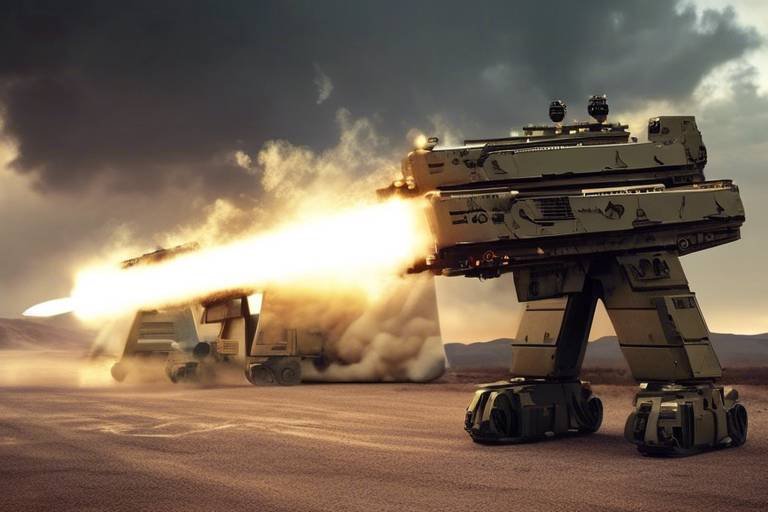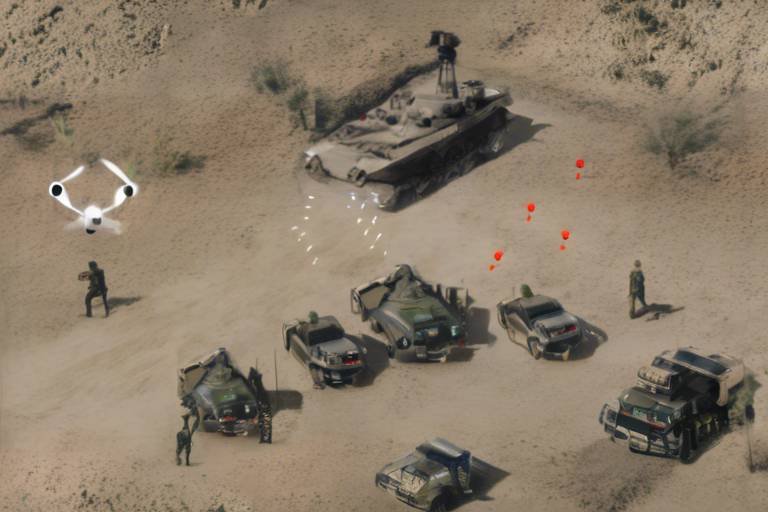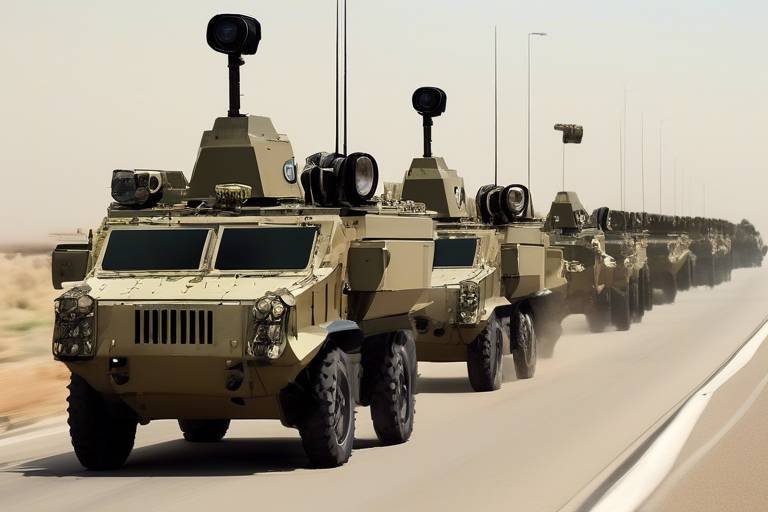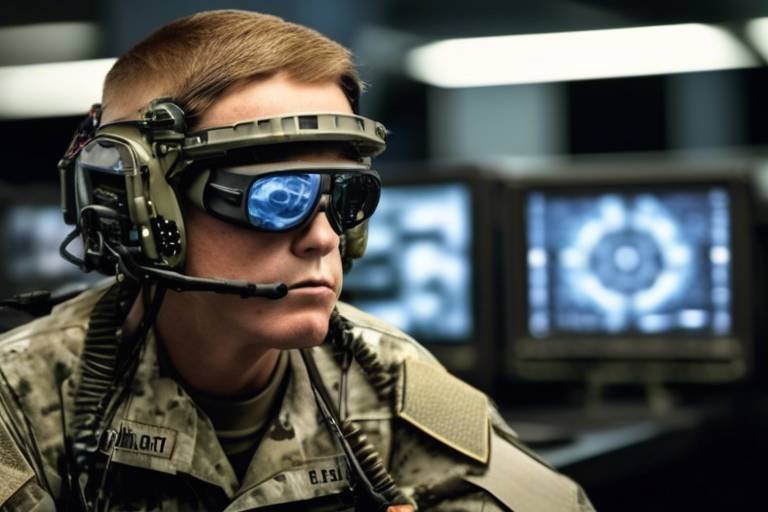The Impact of Advanced Robotics on Military Operations
In recent years, the military landscape has undergone a seismic shift, primarily driven by the advent of advanced robotics. This transformation is not merely a trend; it is a paradigm shift that enhances efficiency, safety, and strategic capabilities in military operations. Imagine a battlefield where soldiers are supported by autonomous systems that can take on the most dangerous tasks, allowing human operatives to focus on critical decision-making. This article delves into the multifaceted impact of robotics on military operations, exploring technological innovations, various applications in combat, the challenges faced during integration, and the future implications of this technological evolution.
The realm of robotics has seen astonishing advancements, particularly in military applications. At the forefront of these innovations are technologies such as artificial intelligence (AI), machine learning, and autonomous systems. These technologies are not just enhancing existing systems; they are reshaping defense strategies entirely. For example, AI algorithms enable machines to analyze vast amounts of data in real-time, making split-second decisions that can save lives. Moreover, autonomous systems can operate in environments that are too hazardous for human soldiers, thus reducing risk and increasing operational effectiveness. The integration of these technologies marks a significant leap forward in the capabilities of armed forces around the globe.
Robots are increasingly finding their place in combat situations, performing a variety of tasks that were once the sole responsibility of human soldiers. From surveillance to logistics and even direct combat roles, the application of robotics is enhancing operational efficiency. The utilization of robotic systems allows for a more strategic approach to warfare, where precision and speed are paramount. For instance, in logistics, robots can transport supplies to the front lines without exposing soldiers to enemy fire. In combat scenarios, they can provide cover or even engage in combat, thus altering the dynamics of traditional warfare.
Unmanned Aerial Vehicles, commonly known as UAVs, have revolutionized aerial reconnaissance and strike capabilities. These drones are equipped with advanced sensors and cameras, allowing them to collect real-time data from the battlefield. This capability provides commanders with invaluable information that can influence strategic decisions. Furthermore, UAVs significantly reduce the risk to human pilots during missions, allowing military operations to be conducted with a lower casualty rate. The operational advantages of UAVs are clear: they can fly longer, gather more information, and execute missions that would be too dangerous for manned aircraft.
Robotic systems excel in intelligence gathering, particularly through advanced surveillance capabilities. UAVs and drones are utilized for real-time reconnaissance, providing strategic advantages that can be the difference between success and failure in military operations. These systems can monitor enemy movements, assess battlefield conditions, and even identify potential threats before they materialize. The ability to gather and analyze data swiftly enhances situational awareness, allowing military leaders to make informed decisions on the fly.
Combat drones are changing the landscape of warfare by engaging in targeted strikes with precision. These unmanned systems can be deployed to neutralize threats with minimal collateral damage, a significant advantage in modern warfare. However, the use of combat drones also raises ethical considerations. Questions about accountability and the morality of robotic decision-making in combat scenarios are hotly debated. As militaries increasingly rely on these technologies, it is crucial to address these ethical dilemmas to ensure responsible use in future engagements.
Ground robotics play a crucial role in various military tasks, from logistics to bomb disposal. These ground-based robotic systems enhance troop safety and operational success by performing dangerous tasks that would otherwise put human lives at risk. For example, bomb disposal robots can safely deactivate explosives, while logistics robots can transport supplies across hazardous terrains. The integration of ground robotics into military operations not only improves efficiency but also significantly reduces the risk of casualties among personnel.
While the integration of robotics offers numerous benefits, it also presents significant challenges. Issues such as cybersecurity, ethical concerns, and the need for comprehensive training for military personnel must be addressed. As military operations become increasingly reliant on robotic systems, the potential for cyber threats grows. Ensuring the integrity and security of these systems is paramount to maintaining operational effectiveness.
The reliance on robotic systems raises substantial cybersecurity concerns. With the increasing sophistication of cyber-attacks, military technology must be safeguarded against potential vulnerabilities. A breach could lead to catastrophic failures, compromising missions and endangering lives. Therefore, investing in robust cybersecurity measures is essential to protect military assets and ensure the safe operation of robotic systems.
The use of autonomous systems in warfare raises profound ethical questions. The moral implications of robotic decision-making, especially in combat scenarios, are the subject of ongoing debates. How do we ensure that these systems operate within the bounds of international law and ethical standards? Addressing these concerns is crucial as we navigate the complexities of modern warfare.
As technology continues to evolve, so will the role of robotics in military operations. Future trends may include the development of more sophisticated AI systems capable of independent decision-making, enhanced collaboration between human soldiers and robotic systems, and the integration of advanced technologies like 5G for improved communication. Militaries worldwide must adapt to these changes to maintain their strategic advantages and ensure the safety of their personnel.
- What are the main benefits of using robotics in military operations?
Robotics enhance efficiency, reduce risks to human soldiers, and improve operational capabilities.
- What ethical concerns are associated with military robotics?
Concerns include accountability for autonomous decisions and compliance with international laws.
- How do UAVs improve military operations?
UAVs provide real-time data collection and reduce risks for human pilots during missions.
- What cybersecurity measures are necessary for military robotics?
Robust cybersecurity protocols must be implemented to protect against potential cyber threats.
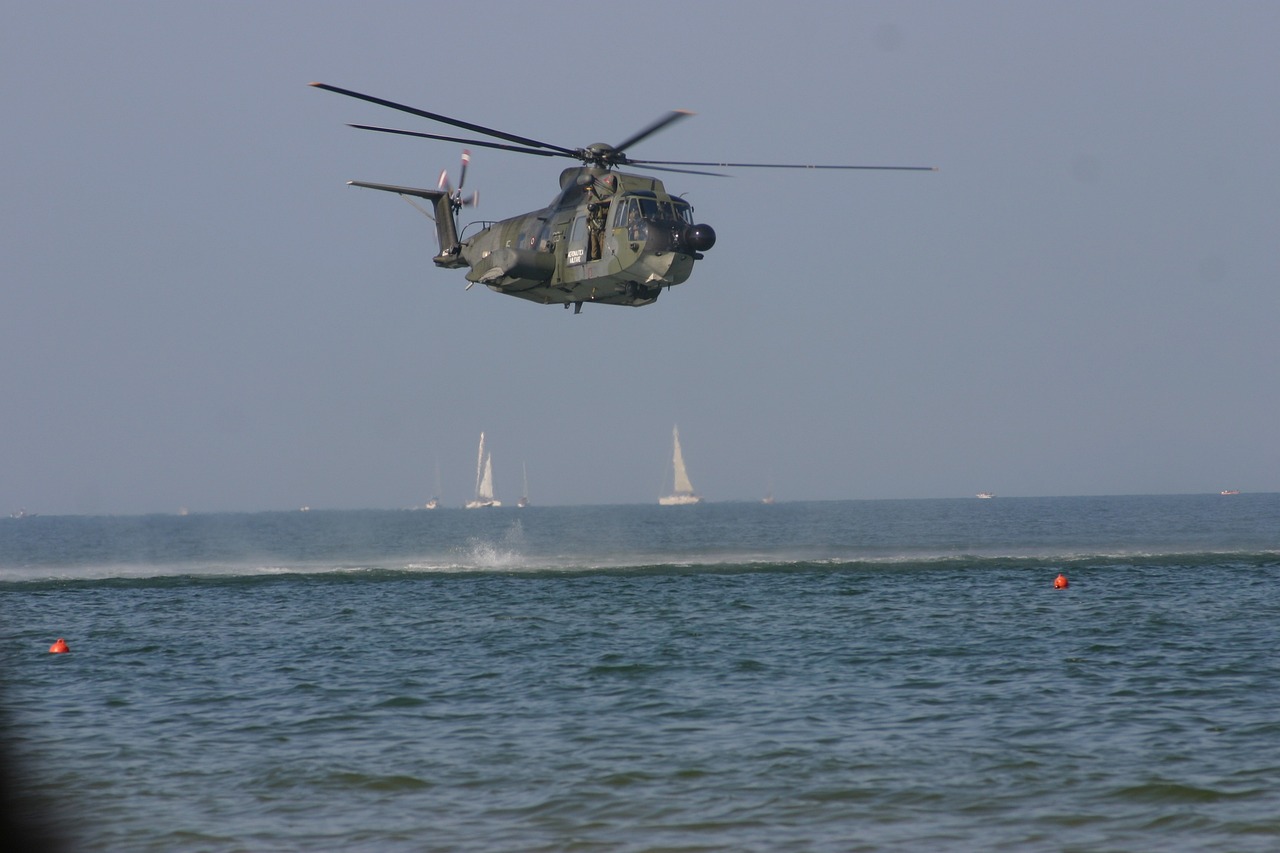
Technological Innovations in Robotics
Recent advancements in robotics technology have sparked a revolution in military operations, introducing cutting-edge tools that enhance efficiency and effectiveness on the battlefield. Imagine a world where soldiers are supported by machines that can think, learn, and adapt in real-time—this is no longer science fiction but a reality reshaping defense strategies. At the heart of this transformation are technologies such as artificial intelligence (AI), machine learning, and autonomous systems, all working in concert to redefine how military forces operate.
AI has become a game-changer, enabling robots to process vast amounts of data and make decisions faster than any human could. For instance, AI-driven systems can analyze battlefield conditions, assess threats, and recommend tactical responses almost instantaneously. This capability not only increases the speed of operations but also significantly reduces the chances of human error, which can be fatal in combat scenarios.
Machine learning, a subset of AI, allows robots to learn from their experiences and improve their performance over time. This means that as they encounter different situations, they can refine their algorithms, making them more effective in future missions. Imagine a robotic unit that gets better at navigating complex terrains or identifying enemy movements with each deployment—it’s like having a soldier who learns and adapts with every battle.
Autonomous systems are another vital aspect of this technological evolution. These systems can operate independently, performing tasks without direct human intervention. This autonomy is particularly beneficial in high-risk environments where sending human troops could lead to unnecessary casualties. For example, unmanned ground vehicles (UGVs) can be deployed for bomb disposal or reconnaissance missions, taking on dangerous roles that would otherwise put lives at risk.
To illustrate the impact of these innovations, consider the following table that highlights some of the key technologies and their military applications:
| Technology | Application | Benefits |
|---|---|---|
| Artificial Intelligence | Data analysis and decision-making | Faster response times, reduced human error |
| Machine Learning | Improving operational efficiency | Adaptive learning, enhanced performance over time |
| Autonomous Systems | Surveillance, logistics, bomb disposal | Minimized risk to human soldiers, operational flexibility |
In summary, the integration of these technological innovations is not just enhancing military capabilities; it's fundamentally changing the nature of warfare itself. As we look to the future, we can expect even more groundbreaking developments that will further blur the lines between human and machine in military contexts. The question isn't whether robotics will play a significant role in future conflicts, but rather how they will shape the very fabric of military strategy and operations.
- What are the main technologies driving advancements in military robotics? The primary technologies include artificial intelligence, machine learning, and autonomous systems.
- How do these technologies improve military operations? They enhance efficiency, reduce human error, and allow for operations in high-risk environments without putting soldiers in danger.
- What ethical concerns arise from the use of robotics in warfare? Ethical concerns include the moral implications of autonomous decision-making and the potential for increased civilian casualties.

Applications of Robotics in Combat
The battlefield is no longer confined to the traditional soldier; it has evolved into a complex environment where advanced robotics play a pivotal role. Robots are increasingly being deployed in combat situations, performing a variety of tasks that not only enhance operational efficiency but also significantly reduce the risk to human life. Imagine a world where machines handle the most dangerous missions—this is not science fiction; it’s the reality of modern warfare.
One of the most significant areas where robotics are making an impact is in surveillance and reconnaissance. Unmanned Aerial Vehicles (UAVs), commonly known as drones, have transformed how military forces gather intelligence. Equipped with high-resolution cameras and advanced sensors, these flying robots can cover vast areas in real-time, providing critical data that informs strategic decisions. The ability to monitor enemy movements without putting a pilot in harm's way is a game-changer. This technology allows for a level of situational awareness that was previously unimaginable.
UAVs have revolutionized aerial reconnaissance and strike capabilities. These flying robots can be deployed for various missions, from gathering intelligence to executing precision strikes. The operational advantages of UAVs are manifold:
- Real-time data collection: UAVs can relay information back to command centers instantaneously, allowing for rapid decision-making.
- Reduced risk to human pilots: By utilizing drones, military forces can minimize the number of personnel exposed to combat situations.
- Cost-effectiveness: UAVs can often be deployed at a fraction of the cost of traditional aircraft, making them an attractive option for military budgets.
Robotic systems enhance intelligence gathering through advanced surveillance capabilities. UAVs and drones are utilized for real-time reconnaissance, providing strategic advantages in military operations. For instance, during conflicts in urban environments, drones can fly over enemy positions, gathering crucial data while remaining out of reach of ground-based defenses. This capability not only informs commanders about enemy troop movements but also helps in planning tactical operations with greater precision.
Combat drones are another critical application of robotics in warfare. These machines engage in targeted strikes, significantly altering the landscape of combat. The effectiveness of combat drones can be attributed to their precision and ability to operate in hostile environments where human soldiers might struggle. However, their use raises ethical considerations, such as the potential for collateral damage and the implications of autonomous decision-making in life-and-death scenarios. As militaries around the world adopt these technologies, the debate surrounding their use continues to grow.
Ground robotics also play a crucial role in various military tasks, from logistics to bomb disposal. Robotic systems such as bomb disposal units are essential in ensuring troop safety. These machines can navigate hazardous environments, disarming explosives without endangering human lives. Additionally, robots are used for logistical support, transporting supplies and equipment to remote locations, thereby enhancing operational success.
| Application | Description | Benefits |
|---|---|---|
| Surveillance | Use of UAVs for real-time monitoring | Enhanced situational awareness |
| Combat | Engaging enemy targets with combat drones | Precision strikes, reduced risk to personnel |
| Logistics | Transporting supplies and equipment | Increased efficiency and safety |
| Bomb Disposal | Remote disarming of explosives | Protection of troops from hazards |
In summary, the applications of robotics in combat are vast and varied. From surveillance to direct engagement, these technologies are reshaping how military operations are conducted. As we move forward, the integration of robotics into combat scenarios will likely continue to evolve, presenting both opportunities and challenges for military forces worldwide.
Q: How do UAVs enhance military operations?
A: UAVs provide real-time data collection, reduce risks to human pilots, and offer cost-effective solutions for surveillance and combat.
Q: What are the ethical concerns surrounding combat drones?
A: Ethical concerns include the potential for collateral damage and the implications of autonomous decision-making in warfare.
Q: How do ground robotics contribute to military logistics?
A: Ground robotics transport supplies, conduct bomb disposal, and enhance overall operational efficiency, ensuring troop safety.

Unmanned Aerial Vehicles (UAVs)
Unmanned Aerial Vehicles, commonly known as UAVs, have become a cornerstone of modern military operations. These remarkable machines, often referred to as drones, have revolutionized the way military forces gather intelligence, conduct surveillance, and engage in combat. Imagine a bird's-eye view of the battlefield, where real-time data flows seamlessly to command centers, providing crucial insights that can make or break a mission. UAVs are not just flying robots; they are advanced technological marvels that enhance situational awareness and operational efficiency.
One of the most significant advantages of UAVs is their ability to collect data without putting human lives at risk. Traditional aerial missions often involve manned aircraft, which carry the inherent danger of enemy fire and the complexities of piloting in hostile environments. In contrast, UAVs can be operated remotely from thousands of miles away, allowing military personnel to oversee operations from a safe distance. This not only protects pilots but also enables more daring missions that would be too risky for manned aircraft.
UAVs come equipped with cutting-edge technology that allows them to perform a variety of roles. For instance, they can be fitted with high-resolution cameras, infrared sensors, and even advanced radar systems. These capabilities allow for:
- Real-time reconnaissance: UAVs can provide live video feeds and data to ground forces, allowing for immediate decision-making.
- Target acquisition: They can identify and track enemy targets with pinpoint accuracy, ensuring that military operations are efficient and effective.
- Logistical support: UAVs can also transport supplies to troops in remote or dangerous locations, reducing the risk to human life.
Moreover, the operational advantages of UAVs extend beyond just reconnaissance and logistics. In combat scenarios, these unmanned systems can engage in targeted strikes, delivering precision munitions with minimal collateral damage. This capability not only enhances the effectiveness of military operations but also raises important ethical questions regarding the use of lethal force from a distance. As UAVs continue to evolve, the implications of their use in warfare will undoubtedly remain a hot topic of discussion among military strategists, ethicists, and policymakers alike.
As we look to the future, the integration of artificial intelligence (AI) into UAV systems is set to further enhance their capabilities. Imagine drones that can autonomously identify targets, navigate complex environments, and even make decisions based on real-time data analysis. This level of sophistication could transform the battlefield, making UAVs an even more critical asset in military operations.
In summary, Unmanned Aerial Vehicles are not just tools of war; they represent a paradigm shift in military strategy. Their ability to operate without risking human lives, coupled with advanced technological capabilities, positions them as essential components of modern warfare. As military forces worldwide continue to adopt and adapt UAV technology, the landscape of combat will undoubtedly change, making way for new tactics and strategies that were once thought impossible.
- What are UAVs used for in the military?
UAVs are primarily used for surveillance, reconnaissance, logistics, and targeted strikes in military operations. - How do UAVs enhance safety for military personnel?
By operating remotely, UAVs reduce the risk to human pilots and allow for missions in dangerous environments without endangering lives. - What are the ethical concerns surrounding the use of UAVs?
The use of UAVs raises questions about the morality of remote warfare, particularly regarding decision-making in lethal situations.
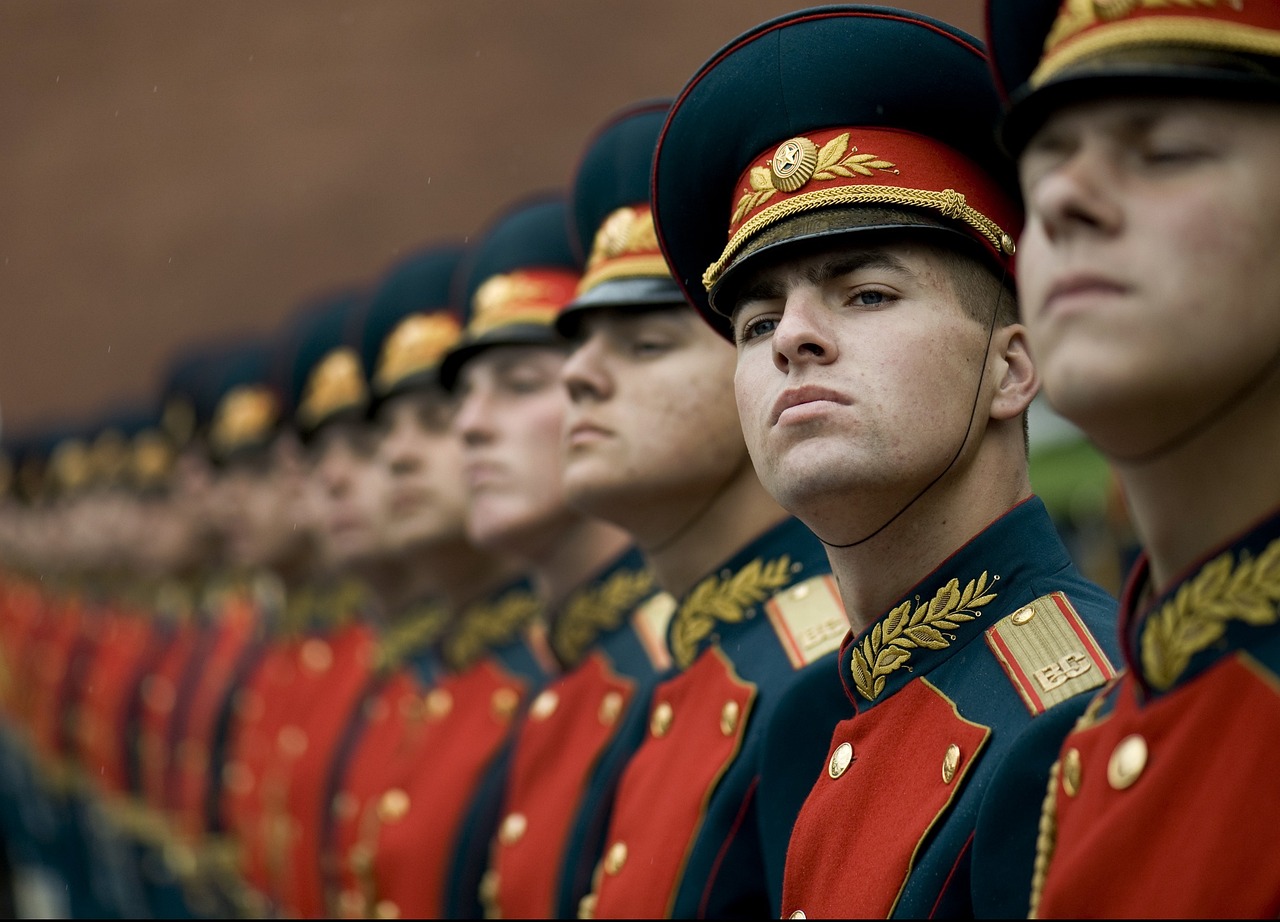
Surveillance and Reconnaissance
In the realm of modern warfare, have become pivotal components that dictate the success of military operations. The advent of robotic systems, particularly Unmanned Aerial Vehicles (UAVs) and drones, has revolutionized how intelligence is gathered and analyzed on the battlefield. Imagine having a bird's-eye view of enemy positions, troop movements, and potential threats without putting human lives at risk. This is precisely what advanced robotics brings to the table.
These robotic systems are equipped with cutting-edge technology that allows for real-time data collection and analysis. They can operate in environments that are too dangerous for human soldiers, providing crucial information that can be used to make informed decisions. For instance, UAVs can fly at high altitudes, capturing high-resolution images and video footage that can be transmitted back to command centers instantly. This ability not only enhances situational awareness but also improves strategic planning and operational efficiency.
Moreover, the integration of artificial intelligence (AI) in these systems allows for advanced pattern recognition and predictive analytics. This means that UAVs can not only gather data but also analyze it to identify potential threats or areas of interest. The result? A more proactive approach to military strategy that can anticipate enemy movements before they even occur.
However, the use of robotic systems in surveillance and reconnaissance is not without its challenges. Issues related to cybersecurity are paramount, as these systems rely heavily on data transmission and connectivity. The risk of hacking or interference can compromise missions and put sensitive information at risk. Therefore, ensuring robust security measures is critical to safeguarding these advanced technologies.
In summary, the role of robotics in surveillance and reconnaissance is not just a trend; it’s a fundamental shift in how militaries operate. The ability to gather and analyze intelligence efficiently and safely can mean the difference between victory and defeat. As technology continues to evolve, we can expect even more sophisticated systems to emerge, further enhancing military capabilities on the battlefield.
- What are UAVs used for in military operations?
UAVs, or Unmanned Aerial Vehicles, are primarily used for surveillance, reconnaissance, and targeted strikes, providing real-time data and reducing risks to human pilots. - How do robotic systems enhance military intelligence?
Robotic systems enhance military intelligence by providing high-resolution data collection, advanced analytics through AI, and the ability to operate in high-risk environments without endangering personnel. - What are the cybersecurity risks associated with military robotics?
The reliance on connected robotic systems introduces vulnerabilities that can be exploited by cyber threats, necessitating robust security measures to protect sensitive data and operations.
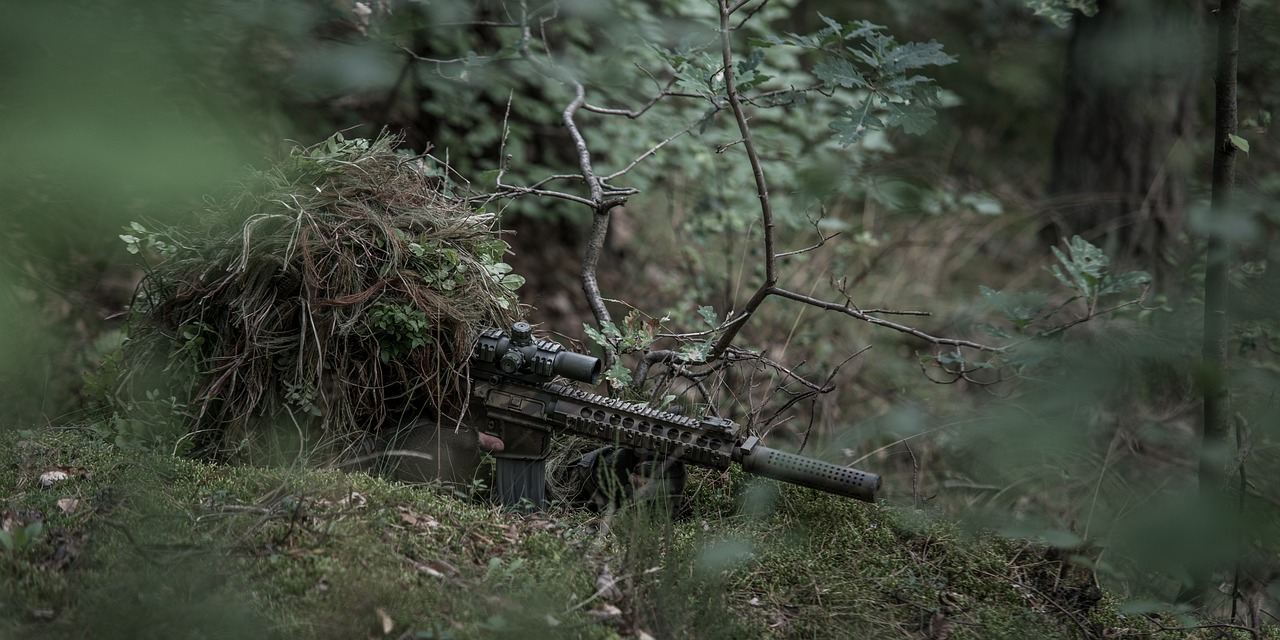
Combat Drones
Combat drones have emerged as a pivotal force in modern warfare, fundamentally altering the way military operations are conducted. These unmanned aerial vehicles (UAVs) are not just flying machines; they represent a significant leap in tactical capabilities. Imagine a soldier on the ground, equipped with real-time intelligence from the sky, allowing them to make informed decisions in the heat of battle. This is the power of combat drones.
One of the most striking advantages of combat drones is their ability to conduct targeted strikes with precision. Unlike traditional warfare methods that often rely on manned aircraft, drones can engage targets with pinpoint accuracy, minimizing collateral damage. This capability not only enhances operational effectiveness but also raises ethical considerations regarding the nature of warfare. How do we balance the benefits of precision strikes against the moral implications of remote warfare?
Furthermore, combat drones are equipped with advanced technologies such as artificial intelligence and machine learning, which allow them to process vast amounts of data in real-time. This enables them to identify potential threats and make rapid decisions without human intervention. However, this autonomy brings forth a host of ethical dilemmas. For instance, who is responsible if a drone makes a mistake during a mission? Is it the operator, the manufacturer, or the military as a whole?
To illustrate the impact of combat drones, consider the following table that outlines some key features and capabilities:
| Feature | Description |
|---|---|
| Autonomy | Drones can operate independently or be controlled remotely, allowing for flexible engagement strategies. |
| Payload Capacity | Equipped to carry various munitions, including precision-guided bombs and missiles. |
| Surveillance | Real-time video and data transmission for enhanced situational awareness. |
| Cost-Effectiveness | Lower operational costs compared to manned aircraft, reducing the overall expenditure of military operations. |
Combat drones have also revolutionized the way intelligence is gathered. They can linger over a battlefield for extended periods, providing continuous surveillance and reconnaissance. This capability is invaluable for military strategists who rely on accurate, up-to-date information to make tactical decisions. The integration of drones into military operations has not only increased the effectiveness of missions but also significantly reduced the risk to human pilots.
As we look to the future, the role of combat drones is expected to expand even further. With advancements in technology, we may see drones equipped with enhanced capabilities like swarming technology, where multiple drones operate in unison to overwhelm enemy defenses. This could change the dynamics of warfare, making it more challenging for adversaries to respond effectively.
In conclusion, while combat drones offer numerous advantages in modern warfare, they also present complex ethical and operational challenges. As military forces around the globe continue to integrate these advanced systems, ongoing discussions about their implications will be crucial in shaping the future of combat.
- What are combat drones used for? Combat drones are primarily used for surveillance, reconnaissance, and targeted strikes in military operations.
- How do combat drones enhance operational efficiency? They provide real-time intelligence, reduce risk to human pilots, and allow for precise targeting of threats.
- What are the ethical concerns surrounding combat drones? Issues include accountability for mistakes, the morality of remote warfare, and the potential for increased military engagement.
- Will combat drones replace traditional aircraft? While drones are becoming more prevalent, they are likely to complement rather than completely replace manned aircraft in military operations.
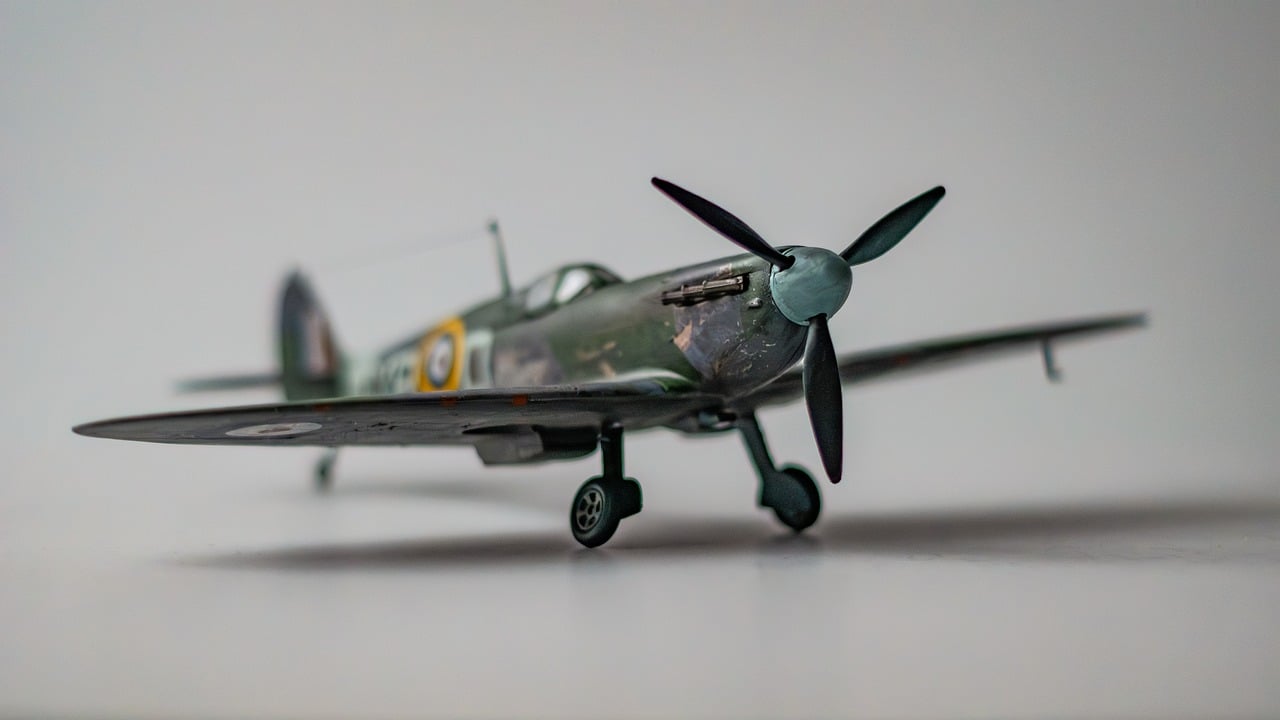
Ground Robotics in Military Operations
Ground robotics are becoming the backbone of modern military operations, providing an array of functionalities that enhance both safety and efficiency. Imagine a battlefield where soldiers are not the first to encounter danger; instead, robots take on the most perilous tasks, allowing human troops to focus on strategic planning and execution. This transformation is not just a futuristic dream; it is happening right now, and it is reshaping how militaries operate globally.
One of the primary applications of ground robotics is in logistics. In a military context, logistics can be the difference between a successful mission and a catastrophic failure. Robotic systems can transport supplies, ammunition, and equipment to frontline troops without putting human lives at risk. For instance, autonomous vehicles equipped with advanced navigation systems can traverse challenging terrains, ensuring that critical resources reach their destination promptly. This capability not only enhances operational efficiency but also minimizes the risk associated with supply runs.
Additionally, ground robotics play a vital role in bomb disposal operations. The use of bomb disposal robots has significantly reduced the number of casualties in explosive ordnance disposal (EOD) missions. These robots are equipped with state-of-the-art sensors and manipulation tools, allowing them to safely disarm or detonate explosives from a distance. This technology not only protects military personnel but also serves to safeguard civilians in conflict zones. The ability to neutralize threats without direct human intervention is a game-changer in ensuring safety on the ground.
Moreover, ground robots are increasingly employed in reconnaissance missions. Equipped with high-definition cameras and sensors, these robots can gather intelligence without exposing soldiers to danger. They can scout enemy positions, monitor troop movements, and provide real-time data to command centers. The information collected can be analyzed to make informed tactical decisions, thereby enhancing the overall effectiveness of military operations.
However, the integration of ground robotics is not without its challenges. There is a pressing need for comprehensive training for military personnel to operate these advanced systems effectively. As technology evolves, so do the tactics required to utilize it optimally. Training programs must keep pace with these advancements to ensure that soldiers can leverage the full potential of robotic systems in the field.
In conclusion, ground robotics are revolutionizing military operations by enhancing safety, efficiency, and operational success. As these technologies continue to develop, we can expect them to play an even more prominent role in shaping the future of warfare. The ongoing evolution of ground robotics promises to create a more strategic and less hazardous environment for military personnel, allowing them to focus on what they do best: protecting and serving.
- What are the primary uses of ground robotics in the military?
Ground robotics are primarily used for logistics, bomb disposal, and reconnaissance missions, enhancing safety and operational efficiency. - How do ground robots improve safety for military personnel?
By taking on dangerous tasks such as bomb disposal and supply transport, ground robots minimize the risk to human soldiers in combat zones. - What challenges do militaries face when integrating ground robotics?
Key challenges include the need for comprehensive training for personnel and addressing potential cybersecurity vulnerabilities associated with robotic systems. - Are ground robots used in civilian applications?
Yes, many technologies developed for military ground robotics are now being adapted for civilian use, including bomb disposal in urban areas and logistics in disaster relief operations.
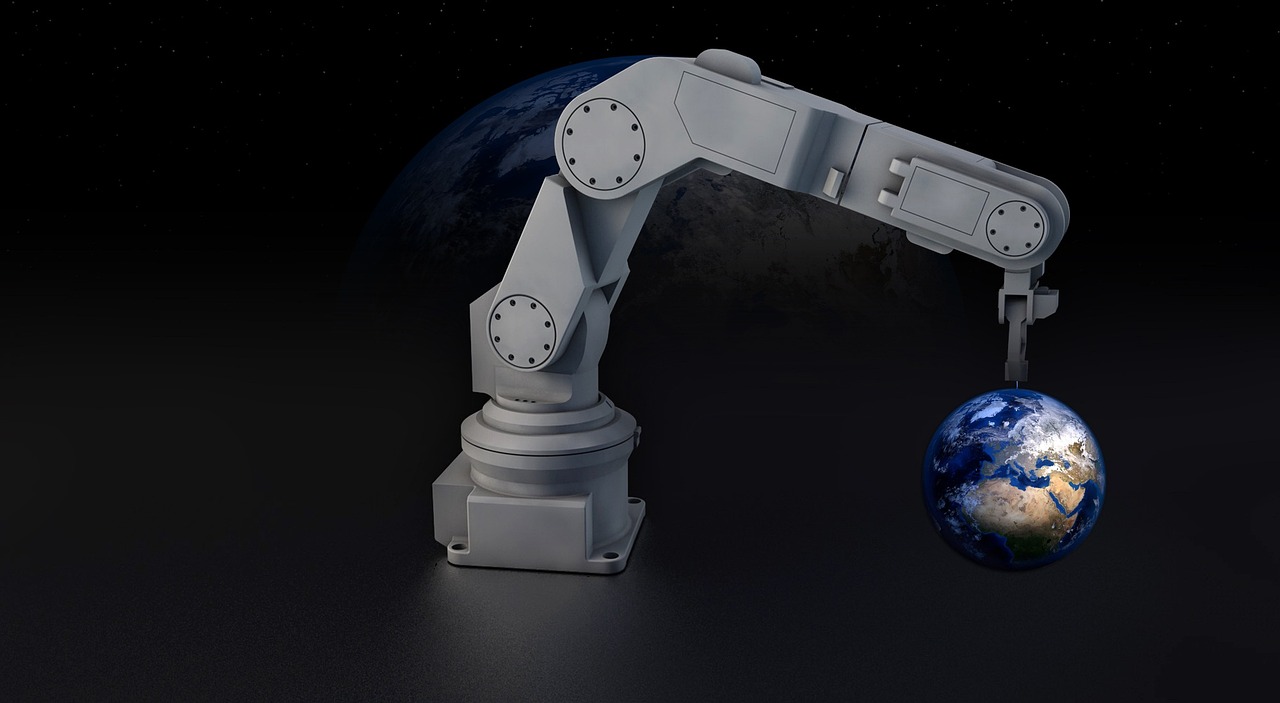
Challenges of Integrating Robotics
As we stand on the brink of a new era in military operations, the integration of robotics is not without its hurdles. While the advantages of advanced robotics are undeniable, there are significant challenges that military organizations must navigate to fully harness their potential. One of the most pressing issues is cybersecurity risks. With the increasing reliance on robotic systems, the military becomes a prime target for cyberattacks. Imagine a scenario where a hacker gains control over a drone mid-mission; the consequences could be catastrophic. This makes it essential for defense departments to invest heavily in cybersecurity measures to protect their robotic assets.
Moreover, the ethical implications of using autonomous systems in warfare cannot be overlooked. The question arises: how much decision-making should be delegated to machines? The idea of robots making life-and-death decisions in combat situations raises serious moral concerns. As we ponder this, we must consider the potential for errors or misjudgments that could arise from robotic decision-making. The debate is ongoing, and military leaders must tread carefully as they integrate these technologies into their operations.
Another challenge lies in the training and adaptation of military personnel. Implementing advanced robotics requires not only technical proficiency but also a shift in mindset. Soldiers and operators must be trained not just to use these systems but to understand their limitations and capabilities. This is no small feat, as it involves a comprehensive overhaul of training programs, which can be both time-consuming and costly. The military must ensure that its personnel are not only skilled in operating robotic systems but also capable of making quick, informed decisions when the unexpected occurs.
Additionally, there are logistical challenges associated with integrating robotics into existing military frameworks. The maintenance of robotic systems can be complex, requiring specialized knowledge and resources. As these systems become more sophisticated, the need for advanced support infrastructure grows. This includes everything from spare parts to software updates, which can strain military budgets and resources. It’s crucial for military planners to account for these logistical needs when developing strategies for robotic integration.
In summary, while the integration of robotics into military operations offers a host of benefits, it also presents significant challenges that must be addressed. From cybersecurity risks to ethical dilemmas and the need for comprehensive training, military organizations must approach this transition with caution and foresight. By acknowledging and tackling these challenges head-on, the military can better position itself to leverage the full potential of advanced robotics in the future.
- What are the main cybersecurity risks associated with military robotics?
Cybersecurity risks include potential hacking attempts that could compromise the functionality of robotic systems, leading to unauthorized control or data breaches. - How do ethical concerns affect the use of autonomous systems in warfare?
Ethical concerns revolve around the morality of allowing machines to make life-and-death decisions, raising questions about accountability and the potential for mistakes. - What type of training is required for military personnel to operate robotic systems?
Training includes technical skills for operating the systems, understanding their limitations, and making informed decisions during operations. - What logistical challenges do militaries face when integrating robotics?
Logistical challenges include the need for specialized maintenance, spare parts, and software updates, which can strain resources and budgets.
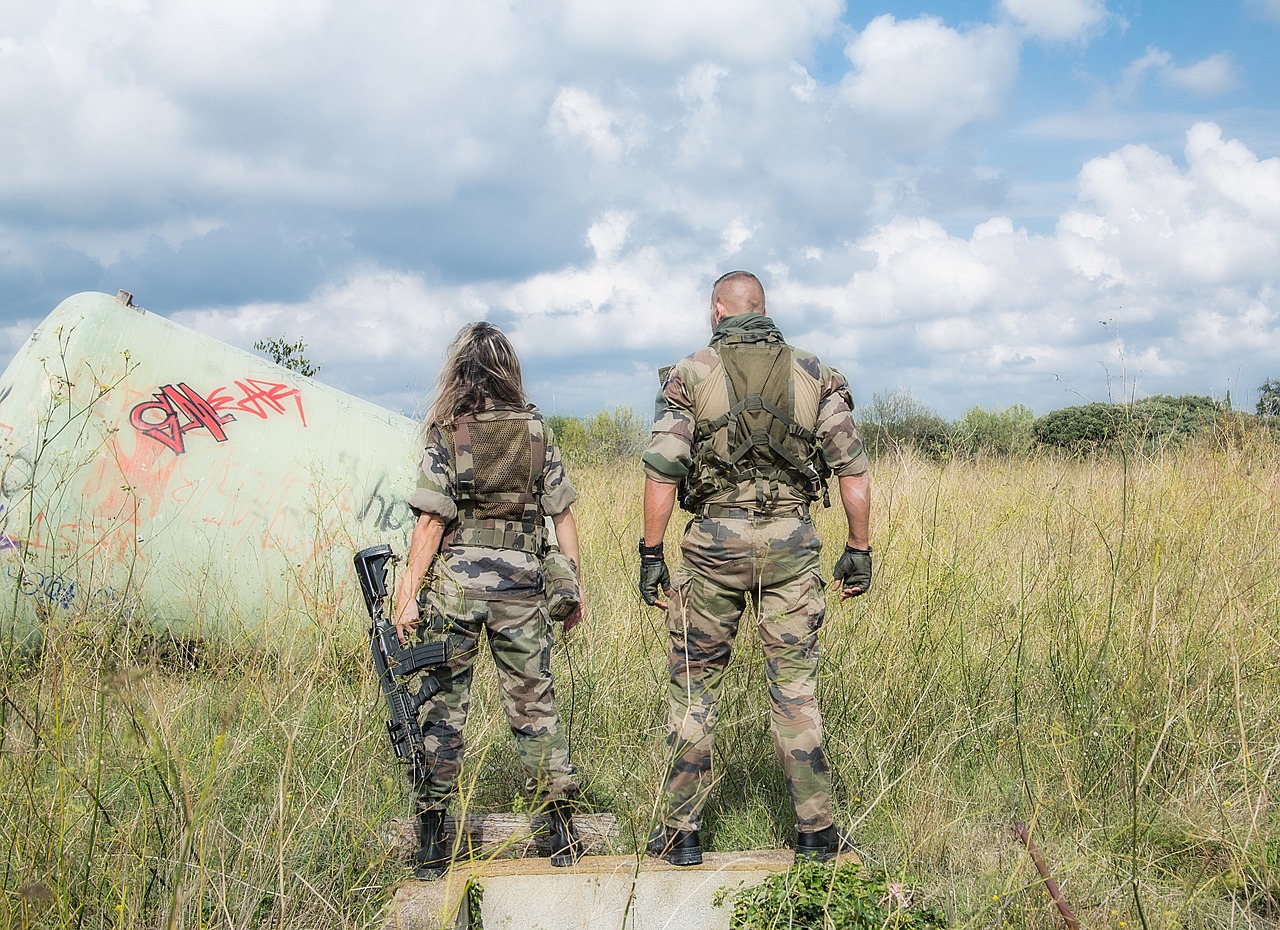
Cybersecurity Risks
The integration of advanced robotics into military operations is undoubtedly a game changer, but it comes with its own set of challenges, particularly in the realm of cybersecurity. As militaries increasingly rely on robotic systems for critical tasks, they expose themselves to a range of vulnerabilities that could be exploited by adversaries. Imagine a scenario where a drone, equipped with sophisticated surveillance technology, is hijacked by a hacker. The consequences could be catastrophic, potentially compromising sensitive intelligence and endangering lives.
One of the primary cybersecurity risks associated with military robotics stems from the reliance on network connectivity. Many robotic systems are designed to communicate with command centers and other units in real-time. This connectivity, while enhancing operational efficiency, also creates potential entry points for cyber attackers. Hackers can exploit weaknesses in the communication protocols or software to gain unauthorized access. For instance, a study conducted by the Pentagon revealed that certain unmanned systems had vulnerabilities that could allow attackers to take control of the device remotely.
Furthermore, the use of artificial intelligence in military robotics introduces additional risks. AI systems learn from vast amounts of data, and if this data is compromised, it could lead to erroneous decision-making. Imagine an autonomous combat drone that misinterprets a target due to manipulated data, leading to unintended consequences. The ethical implications of such scenarios are profound, raising questions about accountability and the potential for civilian casualties.
To mitigate these risks, military organizations must implement robust cybersecurity measures. This includes:
- Regular Software Updates: Keeping software up-to-date is crucial to patching vulnerabilities.
- Encryption Protocols: Utilizing strong encryption can protect data transmission between robotic systems and command centers.
- Continuous Monitoring: Establishing a system for real-time monitoring of robotic operations can help detect anomalies that may indicate a cyber attack.
In addition to these technical measures, there is a pressing need for comprehensive training programs for military personnel. Soldiers must be equipped with the knowledge to recognize potential cybersecurity threats and understand the importance of safeguarding their robotic assets. This training should not only cover the technical aspects of cybersecurity but also address the ethical considerations that come with deploying autonomous systems in combat.
The stakes are high, and as the battlefield becomes increasingly digital, the importance of cybersecurity in military robotics cannot be overstated. As we look to the future, it is essential for military organizations to prioritize cybersecurity to ensure that the advantages of advanced robotics do not come at the cost of operational security.
- What are the main cybersecurity risks associated with military robotics? The main risks include vulnerabilities in network connectivity, potential hijacking of robotic systems, and compromised AI decision-making.
- How can military organizations mitigate cybersecurity risks? They can implement regular software updates, use encryption protocols, and establish continuous monitoring systems.
- Why is training important for military personnel regarding cybersecurity? Training helps personnel recognize potential threats and understand the ethical implications of using autonomous systems in combat.
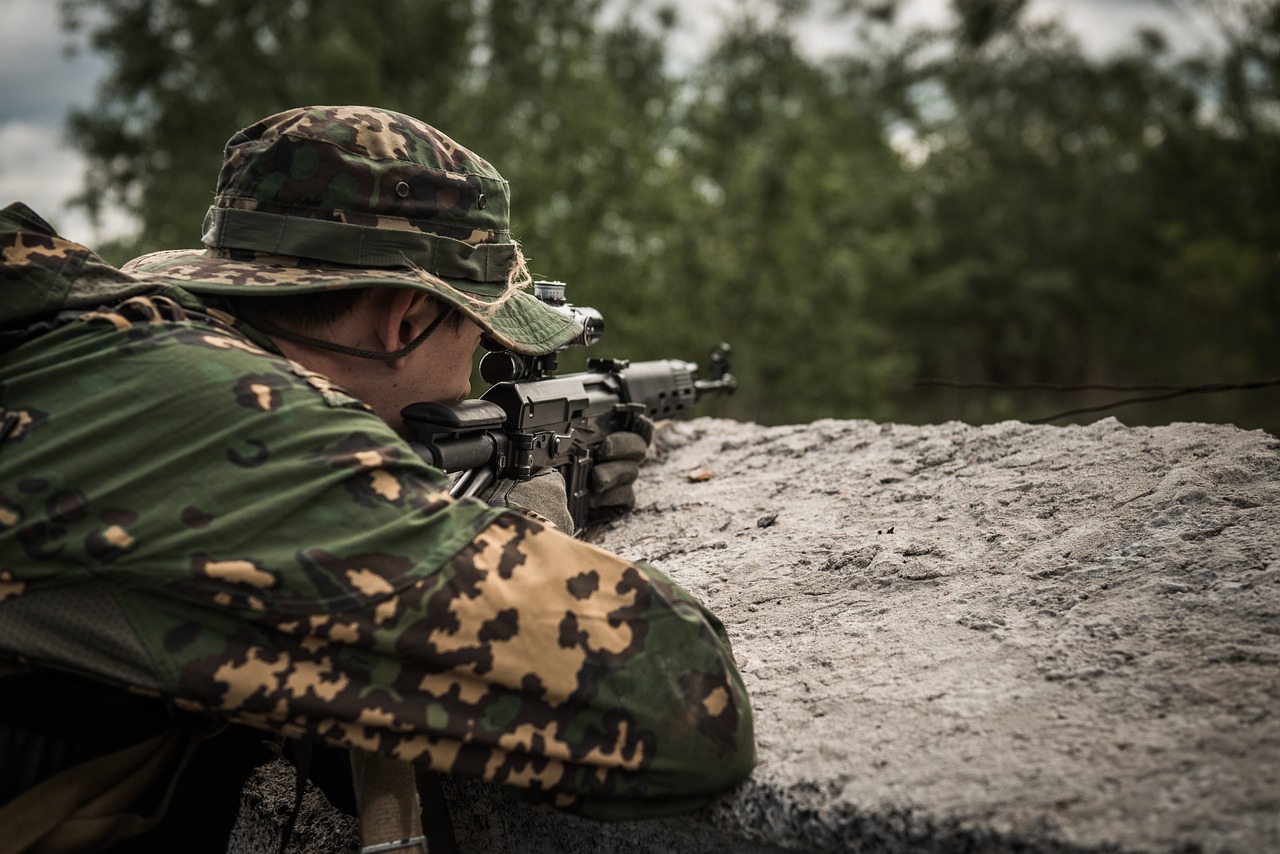
Ethical Considerations
The rise of advanced robotics in military operations has opened up a Pandora's box of ethical dilemmas that society must grapple with. As we deploy machines capable of making life-and-death decisions, we are forced to ask ourselves: What are the moral implications of allowing robots to engage in warfare? Unlike traditional combat, where human soldiers bear the burden of decision-making, autonomous systems can operate independently, raising questions about accountability and the sanctity of human life.
One major concern is the potential for loss of human oversight. In the heat of battle, a robot may be programmed to identify and eliminate threats based on algorithms that lack the nuanced understanding of human emotions and ethics. Imagine a scenario where a drone misidentifies civilians as combatants due to a software glitch or an erroneous data feed. The consequences could be catastrophic, leading to unnecessary loss of innocent lives. This scenario highlights the critical need for strict guidelines and oversight mechanisms to govern the use of such technologies.
Another pressing issue is the accountability of actions taken by autonomous systems. If a robot carries out a strike that results in civilian casualties, who is held responsible? The programmer? The military commander? Or is it the machine itself? This ambiguity complicates the legal and ethical frameworks that govern warfare. As we stand on the brink of an era where machines can make decisions, establishing clear lines of accountability is imperative to ensure justice and ethical compliance.
Moreover, there is a growing concern about the desensitization to violence that may arise from relying on robotic systems. When humans are removed from the battlefield, the emotional weight of warfare could diminish. Soldiers may become less empathetic, viewing combat as a video game rather than a grave responsibility. This detachment could lead to a slippery slope where the value of human life is undermined, making it easier to engage in conflicts without fully understanding the ramifications.
Additionally, the ethical implications of machine learning algorithms used in military robotics cannot be overlooked. These algorithms are trained on vast amounts of data, which may contain biases that inadvertently affect decision-making processes. For instance, if a drone's targeting system is trained on data that reflects historical biases, it may disproportionately target specific demographics or regions. This raises significant ethical questions about fairness and justice in military operations.
In light of these concerns, it is crucial to engage in ongoing discussions about the ethical frameworks that should govern the use of robotics in warfare. Policymakers, military leaders, ethicists, and the public must collaborate to establish comprehensive guidelines that prioritize human rights and ethical considerations. This could involve:
- Developing international treaties that regulate the use of autonomous weapons.
- Implementing rigorous testing and evaluation processes for military AI systems.
- Creating oversight committees to monitor the deployment and use of robotic systems in combat.
Ultimately, as we embrace the technological advancements that robotics offer, we must remain vigilant and proactive in addressing the ethical considerations that come with them. The future of warfare may be shaped by machines, but the moral compass guiding their use must remain firmly in human hands.
- What are the main ethical concerns regarding military robotics? The primary concerns include loss of human oversight, accountability for actions taken by robots, potential desensitization to violence, and biases in machine learning algorithms.
- How can we ensure accountability for autonomous systems in warfare? Establishing clear lines of accountability through legal frameworks, oversight committees, and international treaties is essential for ensuring responsible use of military robotics.
- What role should policymakers play in regulating military robotics? Policymakers should collaborate with military leaders and ethicists to create comprehensive guidelines that prioritize human rights and ethical considerations in the deployment of robotic systems.

The Future of Robotics in Warfare
The future of robotics in warfare is not just a concept; it is an evolving reality that is set to redefine military operations as we know them. As technology advances at a breakneck pace, militaries around the globe are increasingly investing in robotic systems that can perform a variety of roles, from logistics support to direct combat. Imagine a battlefield where drones zip overhead, gathering intelligence while robotic ground units transport supplies or even defuse explosives. This is not science fiction; it's the future of warfare.
One of the most exciting prospects is the integration of artificial intelligence (AI) with robotic systems. AI can enable robots to learn from their environments and make decisions in real-time, enhancing their operational capabilities. For instance, future UAVs might be equipped with advanced algorithms that allow them to autonomously identify targets, assess threats, and execute missions without human intervention. This could drastically reduce response times and improve mission success rates. However, this level of autonomy raises important questions about accountability and decision-making in combat scenarios.
Additionally, the development of swarm robotics is on the horizon. Imagine a group of drones working together seamlessly to achieve a common goal, much like a flock of birds. Swarm robotics could allow for coordinated attacks, where multiple drones can overwhelm a target by working in unison. This technology could be particularly useful in reconnaissance missions, where a swarm can cover a large area quickly, providing real-time data to military strategists.
However, as we look toward this promising future, we must also consider the implications of these advancements. The integration of robotics in warfare will require new strategies, training, and policies. Military personnel will need to be trained not only in the operation of these advanced systems but also in understanding the ethical complexities that arise. For example, how do we ensure that AI-driven systems adhere to the laws of war? What happens if a robotic system makes a mistake? These are challenging questions that military leaders must address as they adapt to the changing landscape of warfare.
Moreover, the potential for cyber warfare cannot be ignored. As military operations become increasingly reliant on robotic systems, the risk of cyber attacks targeting these technologies grows. Future military strategies will need to incorporate robust cybersecurity measures to protect against potential threats that could compromise operational integrity. Imagine a scenario where enemy forces hack into a military drone, turning it against its operators. This is a real risk that must be mitigated through comprehensive planning and advanced security protocols.
In conclusion, the future of robotics in warfare is filled with both promise and peril. As we stand on the brink of this new era, it is essential to strike a balance between harnessing the advantages of advanced robotics and addressing the ethical and practical challenges they present. The decisions we make today will shape the future of military operations and the very nature of warfare itself.
- What role will AI play in future military robotics?
AI will enhance the decision-making capabilities of robotic systems, allowing them to operate autonomously and respond to dynamic battlefield conditions. - How will swarm robotics change military operations?
Swarm robotics will enable coordinated actions among multiple drones, improving reconnaissance and attack capabilities through collective intelligence. - What are the ethical concerns surrounding autonomous military systems?
There are significant ethical questions regarding accountability, decision-making, and adherence to international law when robots are involved in combat. - How can militaries protect their robotic systems from cyber threats?
Robust cybersecurity measures, including encryption and continuous monitoring, will be essential to safeguard military technologies from cyber attacks.
Frequently Asked Questions
- What are the main advantages of using advanced robotics in military operations?
Advanced robotics enhance military operations by improving efficiency, safety, and strategic capabilities. They can perform tasks that are dangerous for humans, such as bomb disposal or surveillance in hostile environments, thereby reducing the risk to personnel.
- How do Unmanned Aerial Vehicles (UAVs) benefit military operations?
UAVs revolutionize aerial reconnaissance and strike capabilities by providing real-time data collection without risking human lives. They offer operational advantages such as enhanced surveillance and the ability to conduct targeted strikes with precision.
- What are the ethical concerns surrounding the use of robotics in warfare?
The use of autonomous systems raises significant ethical questions, particularly regarding decision-making in combat situations. Concerns include accountability for actions taken by robots and the potential for dehumanizing warfare, leading to less consideration for the consequences of military actions.
- What cybersecurity risks are associated with military robotics?
Military robotics are vulnerable to cyber threats, which can compromise their functionality and security. As these systems increasingly rely on interconnected technologies, safeguarding against hacking and unauthorized access becomes critical to maintaining operational integrity.
- What future trends can we expect in military robotics?
Future trends in military robotics may include advancements in artificial intelligence, machine learning, and increased autonomy in robotic systems. As technology evolves, militaries around the world will likely adapt to these changes, enhancing their capabilities and operational strategies.









